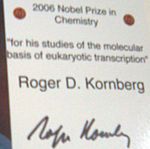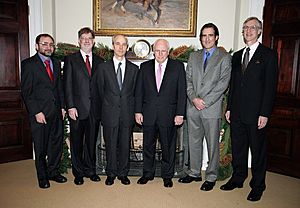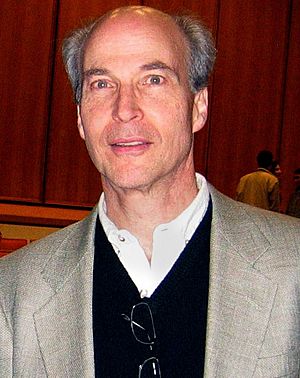Roger D. Kornberg facts for kids
Quick facts for kids
Roger Kornberg
|
|
|---|---|

Kornberg in 2016
|
|
| Born | April 24, 1947 St. Louis, Missouri, U.S.
|
| Education |
|
| Known for | Transmission of genetic information from DNA to RNA |
| Spouse(s) | Yahli Lorch |
| Children | 3 |
| Awards |
|
| Scientific career | |
| Fields | Structural biology |
| Institutions |
|
| Thesis | The Diffusion of Phospholipids in Membranes (1972) |
| Doctoral advisor | Harden M. McConnell |
| Signature | |
 |
|
Roger David Kornberg, born on April 24, 1947, is an American scientist. He is a professor at Stanford University School of Medicine. He studies how living things work at a tiny level. In 2006, he won the Nobel Prize in Chemistry. He won it for his amazing work on how our bodies copy genetic information. This information is stored in DNA and copied to RNA. This process is called transcription. It is how our cells read their instructions.
Contents
Early Life and Learning
Roger Kornberg was born in St. Louis, Missouri. His father, Arthur Kornberg, was also a famous biochemist. Arthur Kornberg even won a Nobel Prize too! Roger's mother, Sylvy Kornberg, was also a biochemist.
Roger went to Harvard University and earned a degree in chemistry in 1967. Later, he got his Ph.D. in chemical physics from Stanford University in 1972. His advisor there was Harden M. McConnell.
Roger Kornberg's Career
After finishing his studies, Roger Kornberg worked as a research fellow. He worked at the Laboratory of Molecular Biology in Cambridge, England. In 1976, he became a professor at Harvard Medical School.
Then, in 1978, he moved to Stanford University School of Medicine. He has been a professor of structural biology there ever since. From 2004 to 2025, he was also the editor of a science journal called Annual Review of Biochemistry.
Amazing Discoveries

Roger Kornberg and his team have made many important discoveries. They helped us understand how our bodies use DNA to make RNA. This process is super important for all living things.
How DNA is Copied
Kornberg studied a special protein called RNA polymerase II. This protein helps copy genetic information from DNA to RNA. He used a method called X-ray crystallography. This method helps scientists see the tiny structures of proteins. He created 3D pictures of these protein groups.
He also discovered something called the nucleosome. Think of DNA as a very long string. Nucleosomes are like spools that the DNA string wraps around. This helps pack the long DNA into the tiny space inside our cells. He found that about 200 "base pairs" of DNA wrap around eight special proteins called histones.
Kornberg also showed that these nucleosomes can stop the copying process. This means they help control which genes are turned on or off.
The Mediator Complex
Roger Kornberg's team also found another important protein group. They called it Mediator. This Mediator complex helps send signals to the RNA polymerase. It tells the polymerase when and how to copy DNA.
The Nobel Prize committee said that finding Mediator was a huge step. It helped us understand how complex living things work. It showed how different parts of our cells work together to control our genes.
Seeing Transcription in Action
Kornberg spent 20 years developing ways to see these tiny structures. He wanted to see how RNA polymerase works at an atomic level. He used X-ray crystallography to get very detailed 3D pictures.
His pictures showed how transcription happens. They showed the DNA, the polymerase, and the RNA all working together. It was like seeing a movie of the process! This helped scientists truly understand how our genetic information is copied.
Awards and Honors
Roger Kornberg has received many awards for his important work. The most famous one is the Nobel Prize in Chemistry in 2006.
Here are some of his other awards:
- 1981: Eli Lilly Award in Biological Chemistry
- 1990: Ciba-Drew Award
- 1997: Harvey Prize
- 2000: Gairdner Foundation International Award
- 2005: Alfred P. Sloan, Jr. Prize
- 2006: Dickson Prize
- 2006: Louisa Gross Horwitz Prize
- 2009: Elected a Foreign Member of the Royal Society
See also
 In Spanish: Roger Kornberg para niños
In Spanish: Roger Kornberg para niños
- List of Jewish Nobel laureates


